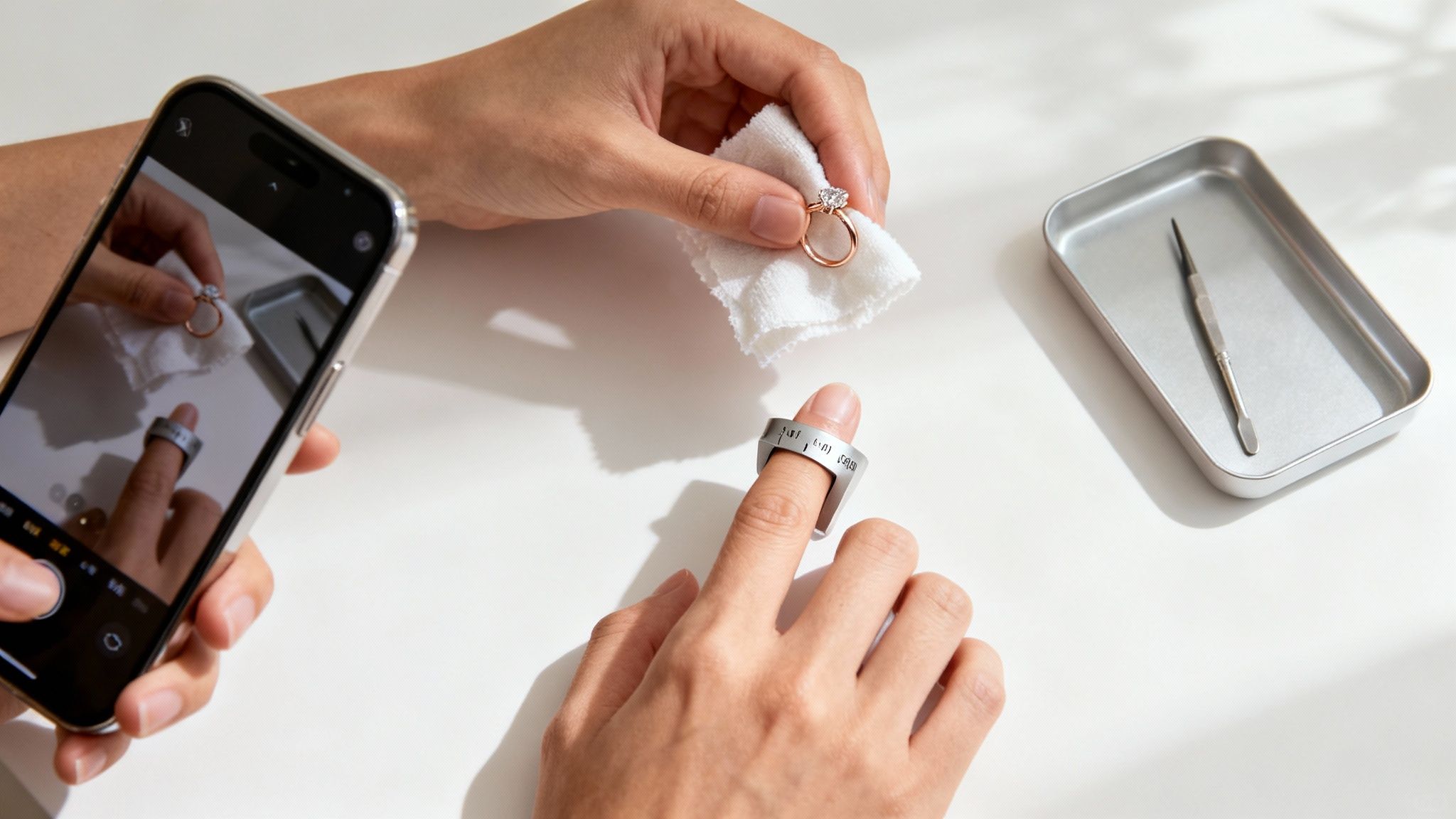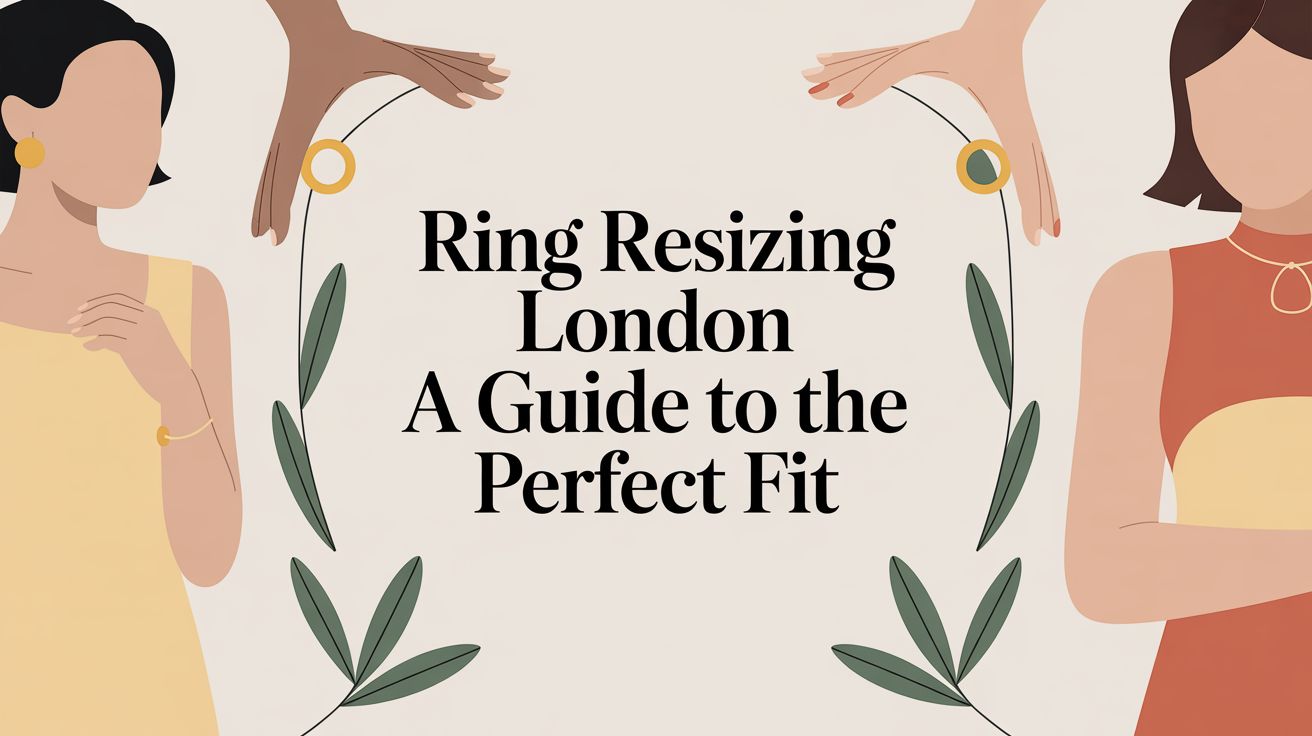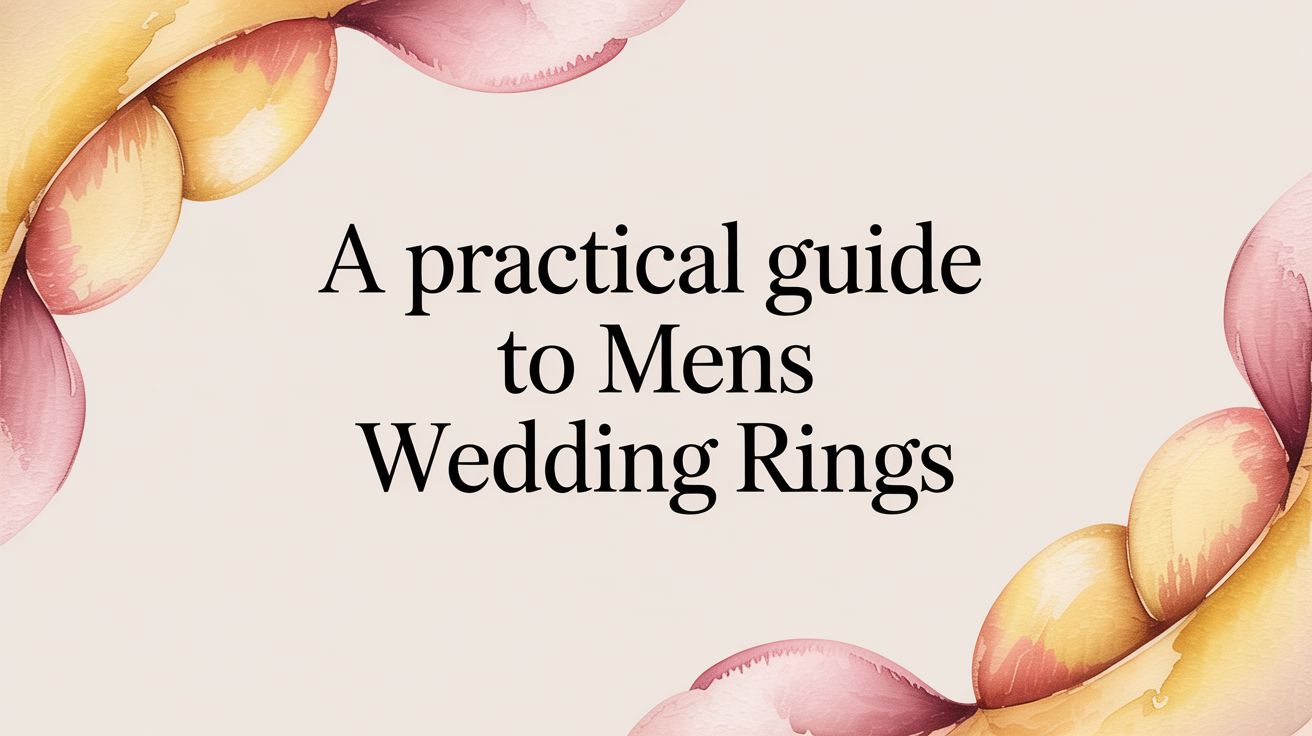A ring that doesn't fit properly isn't just an annoyance; it’s a constant worry. Every time you wash your hands or pull off a glove, there’s that nagging fear of losing a piece you truly treasure. Finding a trusted professional for ring resizing in London is the only way to get that perfect, secure fit you need for complete peace of mind. This guide will walk you through everything, from how the process works and what it costs, to choosing the right workshop for the job.
Why a Perfect Ring Fit Is So Important
When a ring fits just right, it feels like it belongs there—a natural part of your hand. But if it's too loose, it will spin endlessly or, far worse, slip off without you even noticing. And a ring that's too tight is just plain uncomfortable, sometimes even cutting off circulation and being a real struggle to remove. Getting the size spot-on is about protecting your investment and, more importantly, the memories that ring holds.
Life changes, and so do our fingers. An engagement ring bought as a surprise is often a best guess on size. But over the years, things like weight fluctuations, pregnancy, or even just a change in the weather can make a once-perfect fit feel all wrong.
Protecting Your Precious Jewellery
Beyond just comfort, a good fit is vital for the ring’s health. A loose ring gets knocked around more easily, bumping against desks and doors, which can weaken the band or, even worse, loosen the settings holding your stones. This is especially true for delicate pavé bands or intricate vintage pieces where the gems are more exposed.
A well-fitted ring doesn't just prevent loss—it minimises daily wear and tear. It ensures the ring sits correctly, shielding delicate settings and gemstones from the accidental bumps that are so common with ill-fitting jewellery.
The steady demand for these skills shows just how healthy the UK’s jewellery scene is. Valued at around £4.4 billion in 2023, the market is set for serious growth. And with so many people still preferring to buy jewellery in person, the need for expert, hands-on services like ring resizing in London remains as high as ever. You can discover more insights about the UK jewellery industry and its promising future.
Ultimately, resizing is a small but crucial piece of maintenance. It’s what ensures your most treasured pieces stay with you for the long haul, fitting safely and seamlessly into your everyday life.
How Jewellers Resize Your Ring
Ever wondered how a jeweller actually changes the size of a metal band? It’s a craft that blends meticulous precision with true artistry, much like a tailor altering a bespoke suit.
The goal is always a flawless, seamless finish. A properly resized ring should look like it was originally made just for you, with no hint of the work that was done.
Making a Ring Smaller
If your ring is too loose, the process is subtractive. To make a ring smaller, a jeweller will carefully cut out a tiny piece from the bottom of the band (the shank). They then bring the two ends together and expertly solder or laser-weld them, creating a new, smaller circle.
The final step is crucial: polishing the join until it's completely invisible, restoring the ring's perfect shape.
Making a Ring Larger
Making a ring larger usually requires adding to it. The most common method involves cutting the shank and inserting a new piece of perfectly matching metal. This piece is soldered into place, and the entire ring is polished until the addition is undetectable.
This approach ensures the ring's original thickness and strength are maintained.
This infographic illustrates the three pillars of a perfect ring fit—comfort, safety, and durability—which a professional resizing service always aims to achieve.

As the image shows, a successful resize doesn't just change the size; it carefully balances these three essential elements to protect your valuable jewellery for years to come.
A quick heads-up: Most rings can only be safely resized by up to two sizes, up or down. Attempting to go beyond this limit can compromise the ring's structural integrity, especially around delicate gemstone settings.
The right technique is everything. Here’s a quick overview of the methods a skilled jeweller will consider for your ring.
Ring Resizing Methods At a Glance
| Method | Best For | Process Overview | Key Considerations |
|---|---|---|---|
| Stretching | Making a plain band slightly larger (up to half a size). | The ring is placed on a tool that gently expands the metal to the new size. | Not suitable for stone-set rings as it can weaken settings. Can slightly thin the band. |
| Cutting & Adding | Making any ring larger (over half a size). | A section of the shank is cut, and a matching piece of metal is soldered into place. | The gold standard for sizing up. Preserves the ring's thickness and strength. |
| Cutting & Sizing Down | Making any ring smaller. | A small piece is cut from the shank, and the two ends are soldered back together. | The most reliable method for sizing down. The join is polished to become invisible. |
| Sizing Beads | A non-permanent fix for rings that spin or are slightly too large. | Two small metal beads are added to the inside of the band to create a snugger fit. | Great for top-heavy rings or for people with larger knuckles. Can be removed later. |
Ultimately, choosing the right technique is a key part of the ring resizing London jewellers provide. A consultation with an expert at a workshop like Opulence Jewellery Services will determine the safest and most effective method for your specific ring, ensuring it fits perfectly without any clue it was ever altered.
What Determines Ring Resizing Costs in London
When you start searching for ring resizing London services, you'll quickly notice prices aren't fixed. That's because the cost is a direct reflection of the time, skill, and materials needed for your specific ring.
Think of it like tailoring a bespoke suit; altering a simple pair of trousers is far quicker and less expensive than meticulously adjusting a complex, hand-beaded jacket. The final quote from a London jeweller boils down to a few key factors. Getting to grips with these will help you understand the craftsmanship involved and budget accurately for that perfect fit.
The Type of Metal Matters
The metal your ring is made from is one of the biggest drivers of cost. Different metals have completely unique properties, demanding specific tools, techniques, and levels of expertise from the goldsmith.
Gold (Yellow, White, Rose): As the most common metal for resizing, gold is relatively malleable and sets a baseline for pricing. It's worth noting that rose gold can be a little more brittle due to its copper content, sometimes needing extra care.
Platinum: This is a different beast altogether. Platinum is dense, incredibly strong, and has a much higher melting point than gold. It requires a specialist's touch and more intense heat to work with, which naturally pushes up the labour cost. Resizing a platinum ring is typically 20-40% more expensive than a similar gold one.
Silver: As a much softer metal, silver is generally the most affordable to resize. For a skilled jeweller, the process is very straightforward.
Complexity of the Ring Design
The structure of your ring is just as critical as the metal it's made from. A simple, plain band is the most straightforward job you can ask for, but as soon as you introduce intricate designs, you add layers of complexity.
Take a ring with pavé-set stones, where tiny gems are embedded all along the band. Resizing this requires extreme precision. The jeweller has to carefully check and tighten every single stone afterwards to ensure none have been loosened by the change in the ring's curve. That meticulous work takes time, and time adds to the cost.
The more complex the ring's design—especially with channel, pavé, or tension settings—the more labour-intensive the resizing process becomes. Jewellers must protect and secure every single stone, which is a delicate and time-consuming task.
The same goes for rings with detailed engravings or patterns. The goldsmith must not only resize the band but also flawlessly restore the pattern over the join so the work is completely invisible. For a detailed breakdown of how these factors influence the final price, our guide offers more on the cost of resizing a ring in the UK.
The Amount of Resizing Needed
Finally, the degree of change has a direct impact on the price. Making a ring just one size larger or smaller is a standard procedure.
However, if a ring needs to jump several sizes larger, more precious metal must be added to the band. This increases both the material costs and the labour involved.
Conversely, drastically reducing a ring's size can sometimes be more complex than a small adjustment. It can affect the ring's overall shape and structure, requiring more work to restore its perfect circular form without stressing the settings.
How to Find a Trusted Jeweller in London

Handing over a cherished ring is a big deal. Whether it’s a family heirloom passed down through generations or a brand-new engagement ring, you need complete confidence in the person working on it. Finding an expert for ring resizing London is about more than just a good price—it's about skill, honesty, and your peace of mind.
From the famous workshops of Hatton Garden to trusted local jewellers, London has plenty of options. Your job is to find a craftsperson who not only has the technical ability but also truly respects the sentimental value of your piece. A trustworthy jeweller will always take the time to inspect your ring properly, explain the process clearly, and answer all your questions before they even think about starting work.
Look for On-Site Workshops
One of the first questions you should always ask is: "Do you do the resizing here, on-site?" Many high-street shops are just middlemen, sending your precious jewellery away to a centralised workshop you'll never see. While not always a disaster, it introduces risks like loss in transit and a total lack of communication with the person actually handling your ring.
Choosing a jeweller with an on-site workshop gives you some major advantages:
- Direct Accountability: You can often speak directly to the goldsmith who will be working on your ring.
- Faster Turnaround: Services are much quicker without the faff of shipping. In some cases, you might even find a jeweller offering same-day ring resizing in London.
- Better Security: Your ring never leaves the building, which massively cuts the risk of it getting lost or damaged.
Vet Their Reputation and Guarantees
In this day and age, a jeweller's reputation is easy to check. Look for recent, detailed reviews on platforms like Google or Trustpilot. Pay close attention to comments that mention resizing, noting if customers were happy with the final result, the communication, and the overall craftsmanship.
Beyond reviews, a reputable jeweller stands by their work.
Always ask about the guarantee they offer on their craftsmanship. A confident expert will provide a warranty on their resizing, ensuring the join is seamless and secure. This guarantee is your assurance of quality.
The UK wedding ring market is huge—it’s projected to hit around £2.9 billion in 2025. This demand fuels the need for trusted resizing services, especially in a city like London where bespoke and heirloom pieces are so highly valued.
Prioritise a Transparent Consultation
Finally, a thorough and transparent consultation is the mark of a true professional. A skilled jeweller won't just measure your finger and give you a price.
They will:
- Examine Your Ring: They should carefully inspect the band, settings, and any stones for potential issues before starting.
- Discuss the Method: They'll explain exactly how they plan to resize your ring—whether that means adding metal, removing a piece, or using another technique.
- Provide a Clear Quote: You should receive a detailed, upfront quote with no hidden fees.
Choosing the right expert ensures your ring comes back to you fitting perfectly and looking flawless.
When Ring Resizing Isn't an Option
While most rings can be resized beautifully, some designs and materials simply won’t play ball. Trying to alter these pieces can damage their structure, ruin a delicate pattern, or even compromise the gemstones. Knowing these limits from the start is a key part of the ring resizing London process and saves a lot of potential disappointment.
Think of it like tailoring clothes. A simple cotton shirt is easy to take in, but a jacket covered in intricate beading can't just be cut and stitched without wrecking the design. The same idea applies to certain rings where the structure is just too complex to be changed.
Rings with Continuous Designs
Some rings have a pattern that wraps all the way around the band, leaving no plain metal for a jeweller to work on. These are often the most challenging pieces, and sometimes, resizing is simply impossible.
Full Eternity Bands: These rings have an unbroken circle of gemstones set around the entire band. Cutting into it would break this seamless pattern and mess with the precise setting of each stone. Taking a piece out leaves an ugly gap, and adding a section means trying to source and set perfectly matched stones—which is rarely practical.
Intricate Engravings or Milgrain: Rings with detailed patterns that flow around the whole circumference have the same issue. A jeweller can’t cut and rejoin the band without creating a visible seam that interrupts the beautiful, handcrafted design.
Metals That Resist Alteration
Not all metals are made equal when it comes to being worked. While gold, silver, and platinum are a goldsmith's best friends, some modern metals are just too tough for traditional resizing.
Some metals, especially modern alternatives like tungsten and titanium, are chosen for being incredibly hard and scratch-resistant. But that same toughness makes them impossible to cut, solder, and reshape like precious metals.
These materials are simply too strong to be altered with standard workshop tools.
- Tungsten Carbide is incredibly hard but also brittle. It would shatter before it would bend.
- Titanium can sometimes be resized by a tiny amount, but it needs specialist equipment that most workshops don't have.
- Stainless Steel is also very difficult to work with, so most jewellers will avoid resizing it.
If your ring falls into one of these categories, don't lose hope. A chat with an expert jeweller can open up other possibilities. Sometimes, adding small sizing beads inside the band can make a loose ring fit snugly without permanently changing its structure. It’s a brilliant way to preserve the integrity of a challenging design.
Getting Your Ring Ready for Resizing

Before you even step into a workshop, a little prep work at home can make all the difference. Taking just a few minutes ensures the resizing process is as smooth and accurate as possible, which is exactly what you want for a treasured piece.
First things first: try to get a good idea of your finger size. Our fingers swell and shrink throughout the day, reacting to everything from the temperature to what we’ve eaten. For a truly comfortable fit, try measuring at different times—morning, afternoon, and evening—to find your most consistent size.
Next, give your ring a quick, gentle clean with a soft cloth. This isn’t just about making it look nice. A clean ring lets a jeweller properly inspect the band for any thin spots, existing marks, or loose settings that might need attention during the resize.
Here's a tip for your own peace of mind: snap a quick 'before' photo of your ring. Getting a clear shot of any hallmarks or unique details gives you a personal record of its condition before you hand it over.
Final Checks Before You Go
These small steps put you in control and help the professional do their best work. It’s all part of a growing appreciation for quality craftsmanship, which is exactly what’s driving the UK's jewellery market. In 2024, the market hit a value of around £4.5 billion and it's set to keep growing.
With rings being one of the most popular categories, the demand for expert ring resizing in London has never been higher. It shows people care about wearing their jewellery, not just owning it. Find out more about the UK jewellery market trends.
Common Questions About Ring Resizing
It’s completely normal to have a few questions before you hand over a treasured ring for resizing. After all, it's a personal piece. People often wonder about everything from how long it will take to whether it affects the ring's long-term value. Getting clear answers is key to feeling confident.
One of the first things everyone asks is about turnaround time. How long does ring resizing take in London? For a simple, plain band, it might only be a few hours. For more complex designs or stone-set rings, you’re more likely looking at a few days to a week, depending on the workshop's queue. We've put together a more detailed guide on how long ring resizing takes that breaks it all down.
Durability and Value After Resizing
Another common concern is whether a ring can be resized more than once. The short answer is yes, but there's a limit. Each time a ring is cut and soldered, the metal experiences a tiny amount of stress. Most rings can safely be resized two to four times before the integrity of the band starts to become a concern.
A professional resize, done by a skilled jeweller, will absolutely not devalue your ring. In fact, getting the fit right protects its value by preventing it from slipping off or getting damaged. The goal is a seamless, invisible finish.
A shoddy job, on the other hand, can leave a visible seam or a weak spot, which can definitely impact its worth and durability. This is exactly why choosing a reputable expert for ring resizing London services is so crucial.
Are There Alternatives to Permanent Resizing?
What if you're not quite ready for a permanent change, or if your ring simply can't be resized in the traditional way? This is where sizing beads come in.
- What are sizing beads? They're two small metal balls—usually gold or platinum to match your ring—that a jeweller solders onto the inside of the band.
- How do they work? They fill the small gap between your finger and the ring, creating a much snugger fit. This stops the ring from spinning or slipping over your knuckle.
- When are they used? They're the perfect fix for top-heavy rings that always want to slide to one side. They're also great for people whose knuckles are larger than the base of their finger, or for anyone who needs a non-permanent solution.
Sizing beads offer a secure fit without changing the ring’s original structure at all.
At Opulence Jewellery Services, our Hatton Garden workshop provides expert, on-site ring resizing with transparent pricing and meticulous care. Visit us for a consultation and get that perfect fit today.




